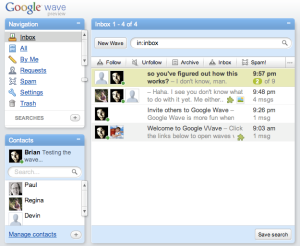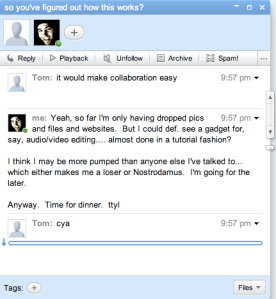We learn best by practicing, working, or doing the activity that we study. (Levinson, New New Media)
The above quote came within the first nine pages of Paul Levinson‘s New New Media (Penguin, 2009) as the author qualifies his methodology citing American Philosopher, John Dewey‘s maxim for learning. Within the early pages of New New Media, Levinson submits the the hallmark of New New Media as the opportunity for “anyone [to] join, play, or work on them” (Levinson, 10). Last night, I had an opportunity to explore exactly what Levinson posits in the early chapters of his latest book, as my application for Google‘s new Google Wave was approved.
To begin, Doctor Wave (who reveals his true name to be “Greg” in the introduction video) provides a brief introduction to the Wave. Though, there are admittedly a plethora of reasons why the length of the intro is so brief, I submit that Google doesn’t want the user to feel pressured into operating the Wave the “standard” way. In fact, my early foray into the Wave has provided anything but a standard operating procedure.
Above, rests my first day of work. As you can see it’s fairly plain, listing a standard (there’s that word again) navigation bar, contacts list, and inbox. However, one less-than-standard characteristic of the Wave.. are the “waves” themselves:

Within the picture, a conversation/discussion/meeting/whatever-one-uses-it-for is taking place between myself and two friends from college. Within the snapshot, the viewer notices the application of “gadgets” into the Wave. Gadgets, or (web) widgets and apps (application software), provide the same user-generated content carrying Facebook toward virtual “Uno,” “Farmville,” “Mob Wars,” and “Friend Finder.” At times annoying (see any Facebook “News Feed” regarding “cow” purchases on Farmville or a “hit” on Mob Wars), the manifestation of these gadgets appears to take root in group collaboration/communication.
Currently, as my conversation with a former co-worker relays, collaborations or group work (in the broadest of definitions) are based from a purely textual perspective. Eventually, the Wave will come incorporate the same video technology (see: Skype, ooVoo, etc.) currently housed on Gmail‘s Google Talk (also known as “gchat”). In fact, multiple video chats operating concurrently lends itself to the anthropotropic characteristics evident in even the earliest stages of Google’s Wave.
Finally, as I wrapped on this post, a close friend “pinged” me:
Putting our heads together, we instantaneously identified “pinging” as Instant Messaging. Further, one of Wave’s most unique characteristics became evident: keystroke to screen communication. Without hitting “Enter,” Regina was able to see every letter I pounded into the “ping” box.
Meaning every time I misspelled a word, relayed misinformation, or wrote something I didn’t want her to read… she had the ability to catch my misspelling, mistakes, or rude demeanor. This addition to the Instant Messaging universe as it’s known delivers a number of immediate changes to the code of conduct or ethical guidelines by which users abided (and still do, for the most part) since IMing’s conception (dating back to Windows Messanger, ICQ, and AOL Instant Messanger).
 The initial shock of key-stroke submission soon wore, as Regina suggested that her “Social Media” plate was quickly filling (and just in time for finals!). Though, it’s far from coming to fruition, my media convergence supposition is idealistic (at best) for the time being. While Wave’s mobile desktop potential is evident, it’s hardly available at the time being.
The initial shock of key-stroke submission soon wore, as Regina suggested that her “Social Media” plate was quickly filling (and just in time for finals!). Though, it’s far from coming to fruition, my media convergence supposition is idealistic (at best) for the time being. While Wave’s mobile desktop potential is evident, it’s hardly available at the time being.
At the end of our discussion, I experienced another novel component of Wave’s “Ping:” editing. Again, ethically speaking, this may have been rude. But justifying my actions with John Dewey’s educational maxim, I corrected Regina’s grammatical mistake. Though my snapshot doesn’t show it, I promise she didn’t mind.
At the end of my session, I have nothing but positive feedback to provide Google. The universe of possibilities for Wave are limitless at the conclusion of Day 1. The most interesting elements to note are the potential for mass-editing (as discussed with Tom regarding video and audio productions) and the potential for Wave as mobile desktop (as detailed just above with Regina). In the end, the most interesting characteristic of my initial foray into Google’s Wave is that I was able to collaborate and sculpt ideas with my friends, co-workers, and peers with relative immediacy and ease.




